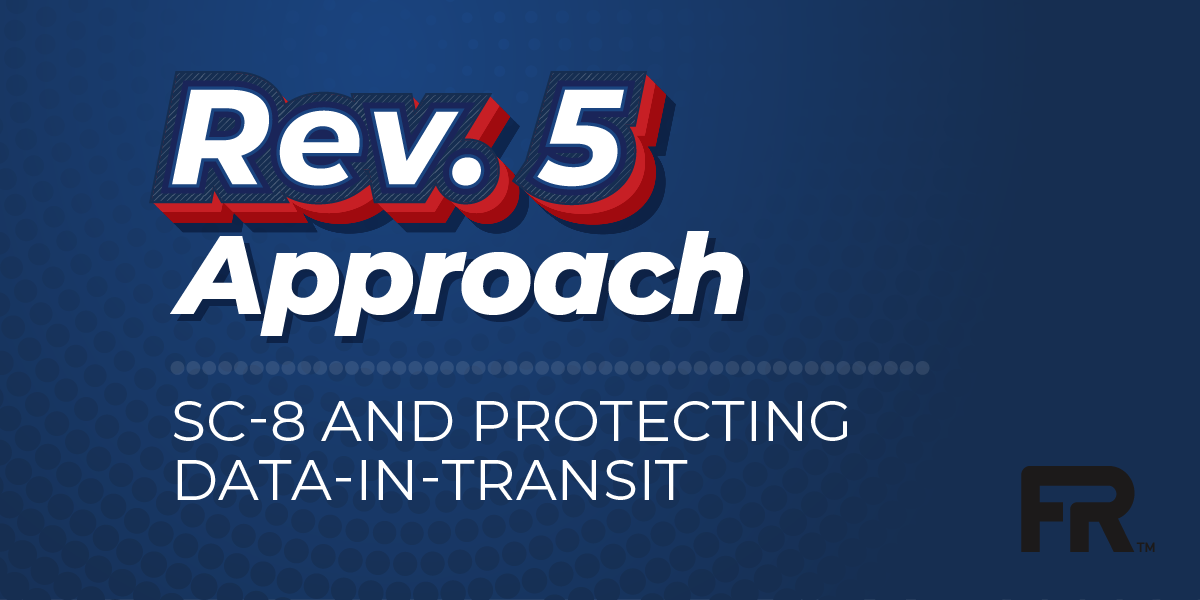The Rev. 5 Approach to SC-8, and Protecting Data-in-Transit
July 13 | 2023
The FedRAMP Program Management Office is driven to ensure the community understands the details and specifics related to the transition from Rev. 4 to Rev. 5 baselines. Important questions have risen regarding the Rev. 5 baseline for SC-8 and its enhancements.. Outlined below are clarifications for SC-8 and its enhancements for protecting data in transit (DIT).
It is helpful to understand that in the FedRAMP Rev. 4 baseline, SC-8(1) addressed both encryption and physical means for protection of DIT. In Rev. 5, the National Institute of Standards and Technology divided the concepts with encryption remaining in SC-8(1), and physical protection moving to the new SC-8(5). Specific to physical protection, the Rev. 4 FedRAMP requirement was for a Protective Distribution System (PDS). Within Rev 5, FedRAMP has modified the requirement to implement a Controlled Access Area (CAA). The changes in Rev 5 make compliance with the physical protection requirements considerably easier to attain.
Data will be considered physically protected in a CAA if it meets Section 2.3 of the Department of Homeland Security’s (DHS’s) Recommended Practice: Improving Industrial Control System Cybersecurity with Defense-in-Depth Strategies. For the purposes of FedRAMP, cloud service providers (CSPs) can meet Section 2.3 of the DHS recommended practice through satisfactory implementation of the following controls: PE-2(1), PE-2(2), PE-2(3), PE-3(2), PE-3(3), PE-6(2), and PE-6(3). Outlined below are key questions and answers to further explain the nuances of SC-8(5) and CAA.
While it is available to any CSP, it is anticipated that this change would be implemented by infrastructure as a service (IaaS)/platform as a service (PaaS) to be made inheritable by customers. For any implementation, keep in mind the following:
- For DIT guaranteed to stay within a single CAA, typically a data center, physical protection via SC-8(5) will be sufficient
- More typically, for DIT that traverses from one CAA/data center to another:
- Physical protection from a sending component can extend from the component to the data center edge
- Encryption protection via SC-8(1) must be in place between the data centers
- Physical protection picks up again from the second data center’s edge to the receiving component
- All of the above must be validated by your independent assessor. For customers of IaaS/PaaS CSOs, all of the above must be declared as inheritable in the IaaS/PaaS customer responsibility matrix before customers can leverage these controls for DIT protection
For all CSPs, note that SC-8(5) CAA protection only applies to DIT inside a data center. Data at rest (DAR) must still be encrypted. CSPs also need to apply SC-13 to encrypted traffic.
Question: If an IaaS complies with the requirements of the CAA, how can a platform as a service (PaaS)/ software as a service (SaaS) leverage that compliance for confidentiality of their data, assuming they would? What are the limits?
Answer: A PaaS/SaaS can leverage the CAA as follows:
- The CAA, and encryption between data centers, as necessary, must be authorized by the IaaS/PaaS CSPs before it can be leveraged as inherited by customers
- As described above, the IaaS CSO documentation must document that SC-8, SC-8(1), and SC-8(5) are inheritable “as a set” for DIT protection, that is, all three must be in place.
- The documentation must clearly state that the following is in place:
- CAA per SC-8(5) for all data centers where DIT may traverse
- DIT encryption is in place between data centers where:
- The encryption is FIPS 140 validated
- The encryption termination points are inside the CAA envelope in all data centers
- Independent assessor validates all of the above
Answer: IaaS/PaaS CSPs must complete the following steps:
- Add SC-8(5), and the applicable PE control enhancements to the SSP template, and document the implementation
- Implement all the PE controls referenced in SC-8(5) to protect DIT from internal components to the edge of the data centers
- Implement FIPS 140 validated encryption from the data center edge to every other data center edge terminating inside the CAA envelope
- The CSP’s independent assessor must validate all of the above
- Submit the above to FedRAMP for authorization - most often as a significant change
- Once authorized, all DIT connections that both originate and terminate inside the IaaS/PaaS boundary will then meet SC-8, SC-8(1), and SC-8(5) requirements, and can be leveraged by customers
As mentioned above, while it is anticipated that this will primarily be implemented by IaaS/PaaS CSPs, the above process can be followed for any CSO.
As the above protections are rolled out by IaaS/PaaS CSPs, the burden of adequately protecting DIT should be greatly relieved as these controls become fully inheritable by customers.
Please see the FedRAMP FAQs for additional questions, and please email info@fedramp.gov regarding SC-8 (5) and CAA.




